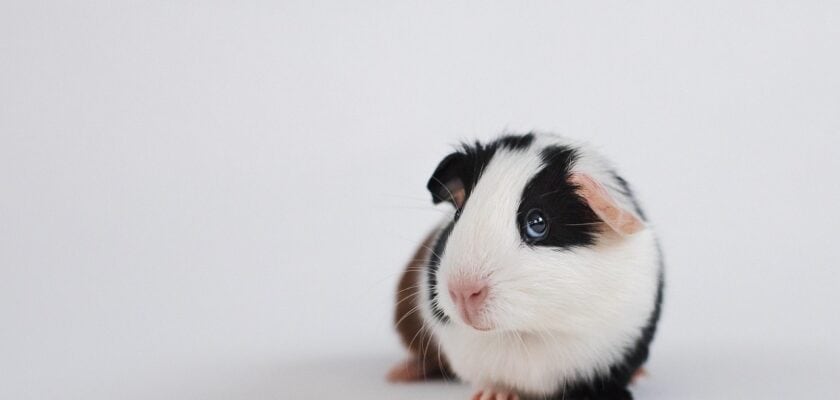I remember the day before I brought Luna home. I had her cage set up, a small bag of hay, and a vague idea of what guinea pigs eat. I thought I was ready. I wasn’t.
I spent that first week scrambling – running back to the pet store for better bedding, swapping out a too-small hideout, and googling things like “is it normal for guinea pigs to hide all day?”
If you’re preparing to bring home your first guinea pig (or ideally, a pair), here’s what I wish I had known. This isn’t a list of everything you could buy – it’s what you should have ready before day one.
Essential Guinea Pig Supplies Before Adoption
Every guinea pig needs a safe and comfortable setup from day one. While you’ll find hundreds of accessories online, only a few categories are truly essential. Below, I’ll explain each one and give you a quick list to make it actionable.
Cage (minimum size & recommended models)
A guinea pig’s cage is their world, so size matters more than anything else. For one or two guinea pigs, you’ll need at least 7.5 sq. ft., though bigger is always better. C&C cages and the Midwest Guinea Habitat are favorites because they’re easy to clean and can expand as your herd grows.
- Quick tip: Avoid small pet store cages marketed as “starter homes”—they’re far too cramped.
Bedding (types: paper, fleece, wood shavings)
Bedding keeps your guinea pig dry, comfortable, and healthy. Paper bedding and fleece liners are the most popular choices because they control odor well and are gentle on little feet. Aspen shavings are safe too, but less absorbent.
- Avoid: Pine and cedar shavings, which contain aromatic oils that can harm guinea pig lungs.
Hay & Food (daily diet essentials)
Guinea pigs need hay 24/7—it keeps their digestion moving and their teeth in check. Timothy hay is the standard, though orchard grass is a softer alternative. Pair hay with fortified pellets (no seeds or colored bits) and daily vegetables like bell pepper, romaine, and cucumber.
- Rule of thumb: Hay should make up 80% of their diet.
Water Bottles & Bowls
Hydration is non‑negotiable. A 16–32 oz drip‑proof bottle plus a heavy ceramic bowl (to prevent tipping) ensures your guinea pigs always have clean water available.
Hideouts & Tunnels
Guinea pigs are prey animals—they feel safe when they can hide. Always provide at least two hideouts per cage, plus a tunnel for play and comfort. Wooden houses, plastic igloos, and fleece tunnels are all good options.
Grooming & Health Basics
While guinea pigs are fairly low‑maintenance, you’ll need a small set of tools: nail clippers, a soft brush, and styptic powder in case of quicked nails. A small kitchen scale is also useful for weekly weigh‑ins, which can alert you to health issues early.
Guinea Pig Starter Kit vs Buying Supplies Separately
Starter kits look convenient, but most include undersized cages and low‑quality accessories. If you want comfort, hygiene, and durability, choosing each item separately usually wins.
| Option | Pros | Cons |
|---|---|---|
| Starter Kit | Quick setup; lower upfront cost | Cage usually too small; flimsy accessories; you’ll replace things fast |
| Buy Separately | Right size + better quality; fits your space | Higher upfront cost; more decisions |
Recommendation: Buy separately for long-term health and comfort.
Cost Breakdown – First Month with a Guinea Pig
| Item | Estimated Cost (USD) |
|---|---|
| Cage (≥7.5 sq ft) | $90–140 |
| Bedding (first bag/liner) | $20–40 |
| Hay & Pellets | $25–45 |
| Water Bottle & Heavy Bowl | $15–25 |
| 2 Hideouts & Tunnel | $30–60 |
| Nail Clippers & Styptic | $12–20 |
| Total Estimate | $192–330 |
Where to Buy Guinea Pig Supplies
Online
In‑Store
- PetSmart / Petco – see sizes in person, same‑day pickup
- Local pet stores – support local, ask for cage dimensions
- Rescues – sometimes include starter items or discounts
Checklist – What to Have Before Bringing Your Guinea Pig Home
- Cage ≥7.5 sq ft (10+ for two)
- Paper bedding or fleece liners
- Unlimited Timothy hay (or orchard grass for variety)
- Timothy‑based pellets (no seeds/colored bits; with vitamin C)
- Water bottle (16–32 oz) & heavy ceramic bowl
- 2+ hideouts and one tunnel
- Nail clippers & styptic powder
- Veggie starter kit (bell pepper, romaine, cucumber)
FAQ – Guinea Pig Supplies
What do I need to buy before getting a guinea pig?
You’ll need a cage (at least 7.5 sq ft), bedding, unlimited hay, fortified pellets, water bottle, ceramic bowl, two hideouts, and grooming tools.
How much does it cost to own a guinea pig?
Expect an initial setup cost of $175–315, plus monthly expenses for hay, bedding, and vegetables.
Is it better to buy a starter kit or supplies separately?
Buying supplies separately ensures the right cage size and better quality. Starter kits are convenient but usually too small.
What is the minimum cage size for 2 guinea pigs?
At least 10 sq ft. Larger cages reduce stress and allow natural behaviors.
Can guinea pigs live without hay?
No. Hay is essential for digestion and dental health, and must be available 24/7.
Final Tips Before Adoption
Guinea pigs are simple, but not low-maintenance. Start with the right setup and they’ll thrive. Get it wrong, and you’ll spend more time fixing problems than enjoying them.
Focus on the essentials. Don’t overspend on toys or gimmicks just yet. Your first goal is to make them feel safe, comfortable, and well-fed.
And if you’re on the fence – adopt two. They’re social creatures, and watching them interact is half the fun.
Disclaimer: This article is for informational purposes only. Always consult a veterinarian for guinea pig health and care advice.
Sources: RSPCA, Humane Society, ASPCA.


[…] setup? Check our starter supplies guide for a printable checklist and cost […]